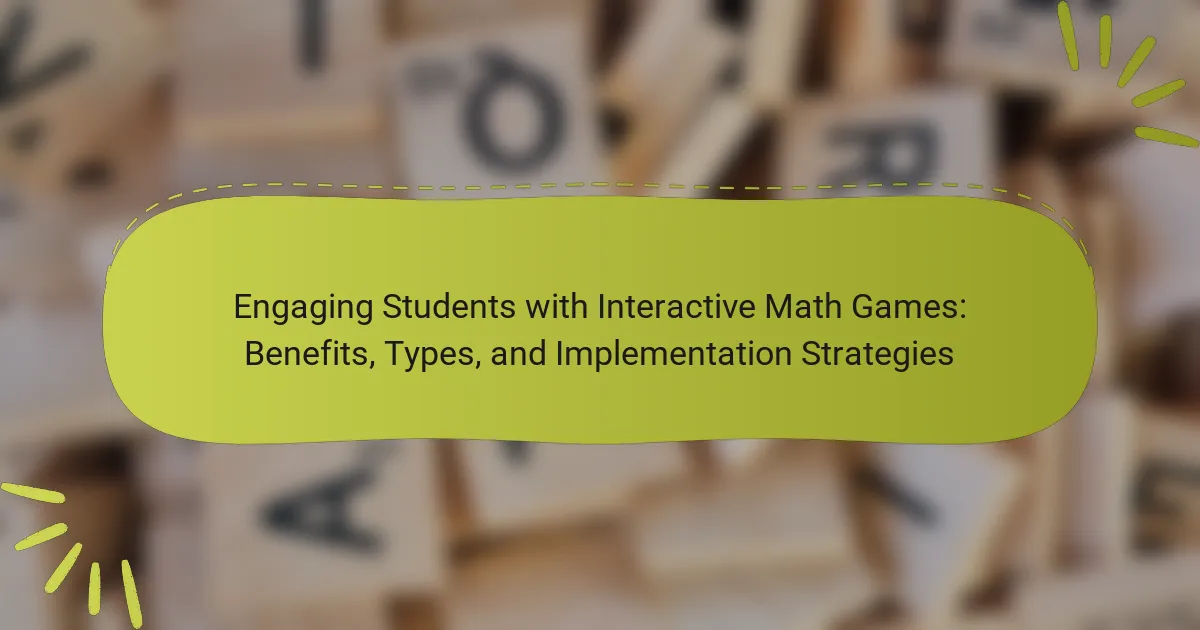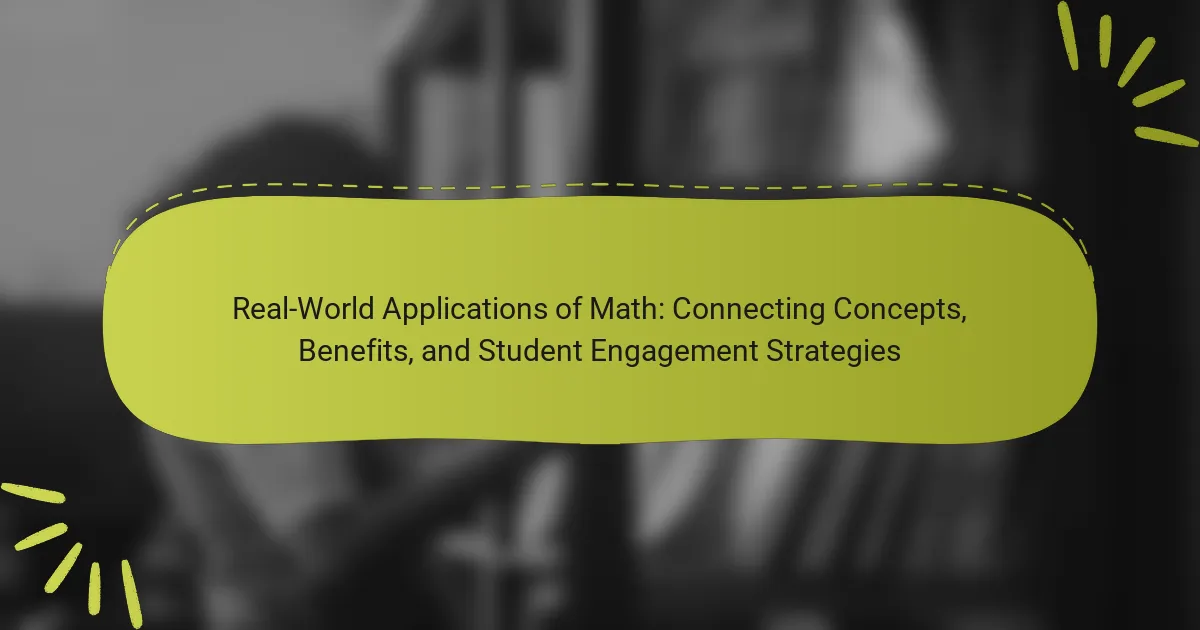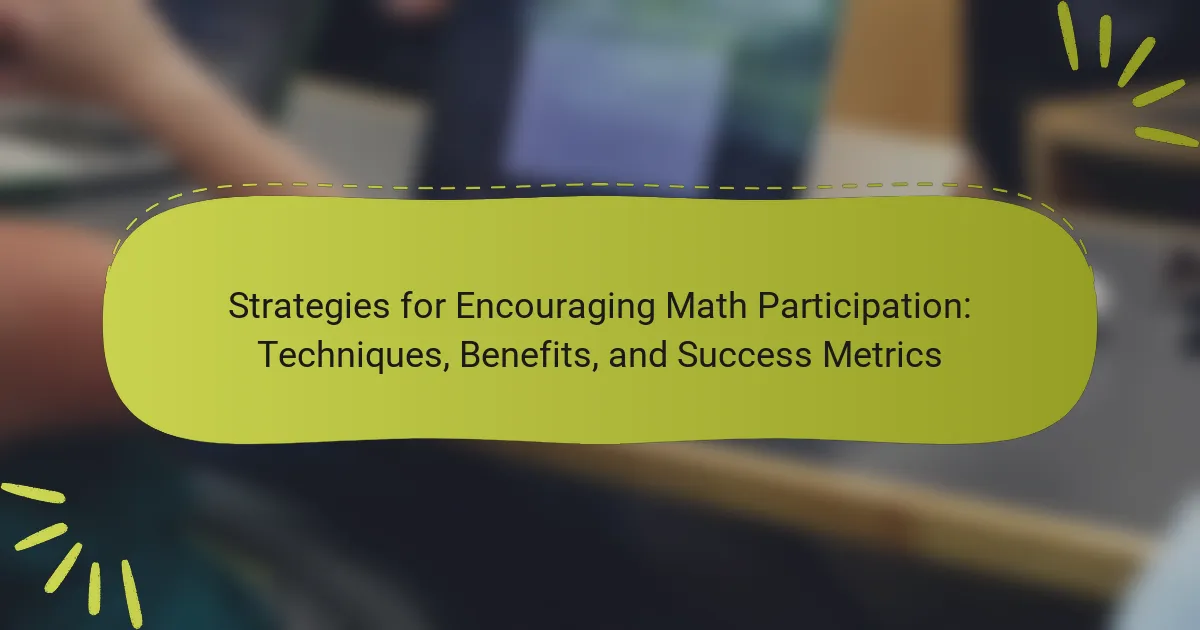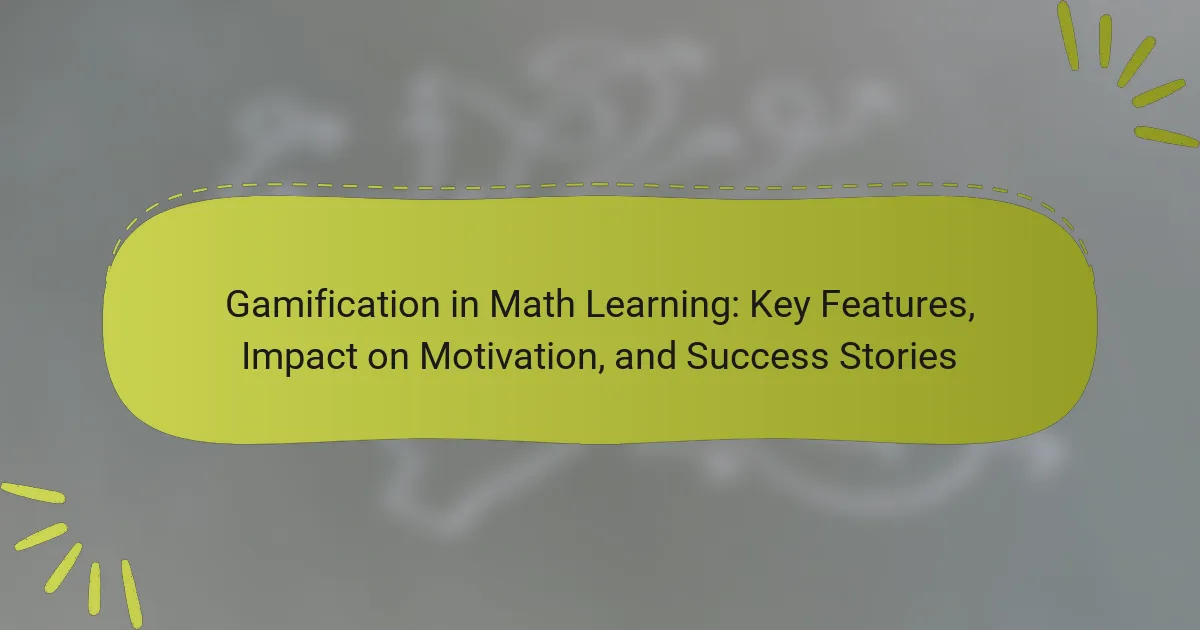Collaborative learning in mathematics is an educational approach where students work together to solve problems, enhancing their understanding and retention of mathematical concepts. This method promotes interaction, discussion, and the sharing of diverse perspectives among peers, leading to improved problem-solving skills and academic performance. Research indicates that students engaged in collaborative learning exhibit better assessment outcomes and develop essential social skills and teamwork capabilities. Best practices for implementing this approach include forming diverse groups, establishing clear goals, and providing structured activities, all of which contribute to a supportive learning environment and foster positive attitudes towards mathematics.
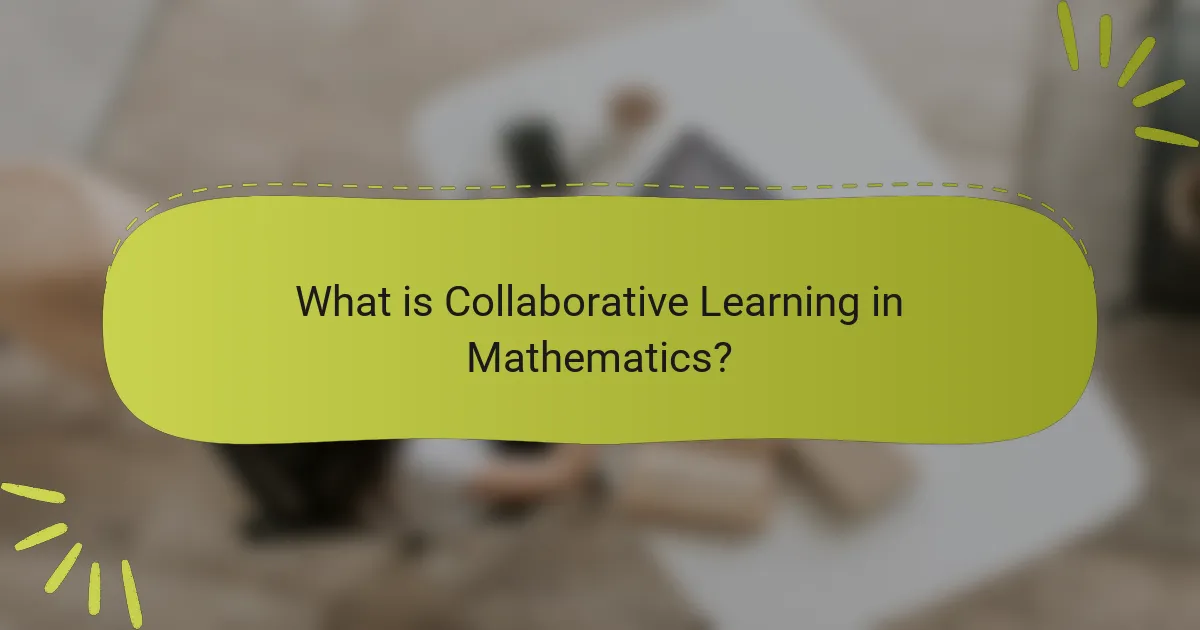
What is Collaborative Learning in Mathematics?
Collaborative learning in mathematics is an educational approach where students work together to solve problems. This method encourages interaction and discussion among peers. Students share different strategies and perspectives. Collaboration enhances understanding through peer explanations. Research shows that this approach improves problem-solving skills. It fosters a deeper comprehension of mathematical concepts. Collaborative learning also promotes social skills and teamwork. Studies indicate that students engaged in collaborative learning perform better academically.
How does Collaborative Learning enhance mathematical understanding?
Collaborative learning enhances mathematical understanding by promoting active engagement among students. It allows learners to discuss and solve problems together. This interaction helps clarify concepts through peer explanations. Students can confront and resolve misunderstandings collectively. Research shows that collaborative learning improves problem-solving skills. A study by Johnson and Johnson (1999) found that students in collaborative settings performed better in mathematics. They showed higher retention of concepts and greater motivation. Collaborative learning also fosters critical thinking and communication skills. These skills are essential for mastering complex mathematical ideas.
What are the key principles of Collaborative Learning in Mathematics?
The key principles of Collaborative Learning in Mathematics include interdependence, individual accountability, and face-to-face interaction. Interdependence refers to the reliance among group members to achieve a common goal. This principle fosters teamwork and collective responsibility for learning outcomes. Individual accountability ensures that each student contributes to the group’s work and understands the material. This principle is crucial for maintaining high standards of learning. Face-to-face interaction promotes communication and discussion among students. It allows them to articulate their thoughts and clarify their understanding. Research shows that these principles enhance problem-solving skills and deepen understanding of mathematical concepts. Studies indicate that students engaged in collaborative learning perform better academically compared to those who learn independently.
How does group dynamics influence the learning process in mathematics?
Group dynamics significantly influence the learning process in mathematics. Collaborative environments foster communication and peer interaction. These interactions enhance understanding through shared problem-solving. Students often clarify concepts by explaining them to peers. This peer-to-peer teaching reinforces their own learning. Research shows that group work can lead to improved mathematical performance. A study by Johnson and Johnson found that cooperative learning increases student achievement. Positive group dynamics also boost motivation and engagement in mathematics. Students feel more accountable when working in groups. This accountability encourages persistence in challenging tasks. Overall, effective group dynamics create a supportive learning atmosphere that enhances mathematical understanding.
What techniques are commonly used in Collaborative Learning for Mathematics?
Common techniques used in Collaborative Learning for Mathematics include group problem-solving, peer teaching, and mathematical discussions. Group problem-solving encourages students to work together to tackle complex math problems. This technique fosters communication and critical thinking skills. Peer teaching allows students to explain concepts to one another, enhancing understanding. Mathematical discussions involve students sharing their thought processes and solutions, promoting deeper engagement with the material. Research shows that these techniques improve student performance and foster a positive learning environment. Studies indicate that collaborative learning can lead to higher retention rates and improved problem-solving abilities in mathematics.
What are the different formats of Collaborative Learning activities?
Collaborative Learning activities can take various formats. Common formats include group projects, where students work together on a specific task. Peer teaching allows students to explain concepts to each other. Discussion groups facilitate sharing ideas and perspectives. Case studies involve analyzing real-world scenarios collaboratively. Jigsaw activities require students to learn different segments of a topic and teach their peers. Online collaborative tools enable remote teamwork and communication. Each format enhances engagement and learning outcomes in educational settings.
How can technology facilitate Collaborative Learning in Mathematics?
Technology facilitates collaborative learning in mathematics by providing interactive platforms for students to engage with each other. Tools such as online discussion forums enable real-time communication among peers. Collaborative software like Google Docs allows simultaneous editing of mathematical problems, fostering teamwork. Virtual whiteboards can illustrate concepts collectively, enhancing understanding. Learning management systems offer resources that students can access and discuss together. Video conferencing tools support group work, regardless of location. Research shows that technology integration improves student engagement and performance in mathematics. A study by the National Education Association found that technology-enhanced collaboration leads to higher achievement levels.
What benefits does Collaborative Learning in Mathematics provide?
Collaborative learning in mathematics enhances student engagement and understanding of concepts. It fosters critical thinking and problem-solving skills. Students learn to communicate effectively with peers. This interaction promotes a deeper comprehension of mathematical ideas. Research shows that collaborative learning can lead to improved academic performance. A study by Johnson and Johnson (1999) indicates that students in collaborative settings often outperform those in traditional classrooms. Additionally, collaboration encourages a sense of community and support among learners. This social aspect can reduce anxiety related to mathematics. Overall, collaborative learning provides numerous advantages for students in mathematics education.
How does Collaborative Learning impact student motivation and engagement?
Collaborative learning significantly enhances student motivation and engagement. It fosters a sense of belonging among students. When students work together, they feel more connected to their peers. This connection can lead to increased participation in class activities. Research shows that collaborative learning promotes active learning. Active learning methods have been linked to higher levels of student motivation. According to a study by Johnson and Johnson (1999), students in collaborative settings show greater motivation compared to those in traditional learning environments. Additionally, collaborative learning encourages peer support and feedback. This support can boost students’ confidence and willingness to engage in discussions. Overall, collaborative learning creates an interactive environment that motivates students to participate actively.
What cognitive skills are developed through Collaborative Learning in Mathematics?
Collaborative learning in mathematics develops several cognitive skills. These include critical thinking, problem-solving, and communication skills. Students engage in discussions that enhance their understanding of mathematical concepts. They learn to analyze problems from different perspectives. This interaction fosters deeper comprehension of mathematical principles. Research shows that collaborative learning improves retention of knowledge. A study by Johnson et al. (1998) found that students in collaborative settings perform better academically. Additionally, teamwork in math helps students to articulate their thought processes clearly. Overall, collaborative learning significantly boosts cognitive development in mathematics.
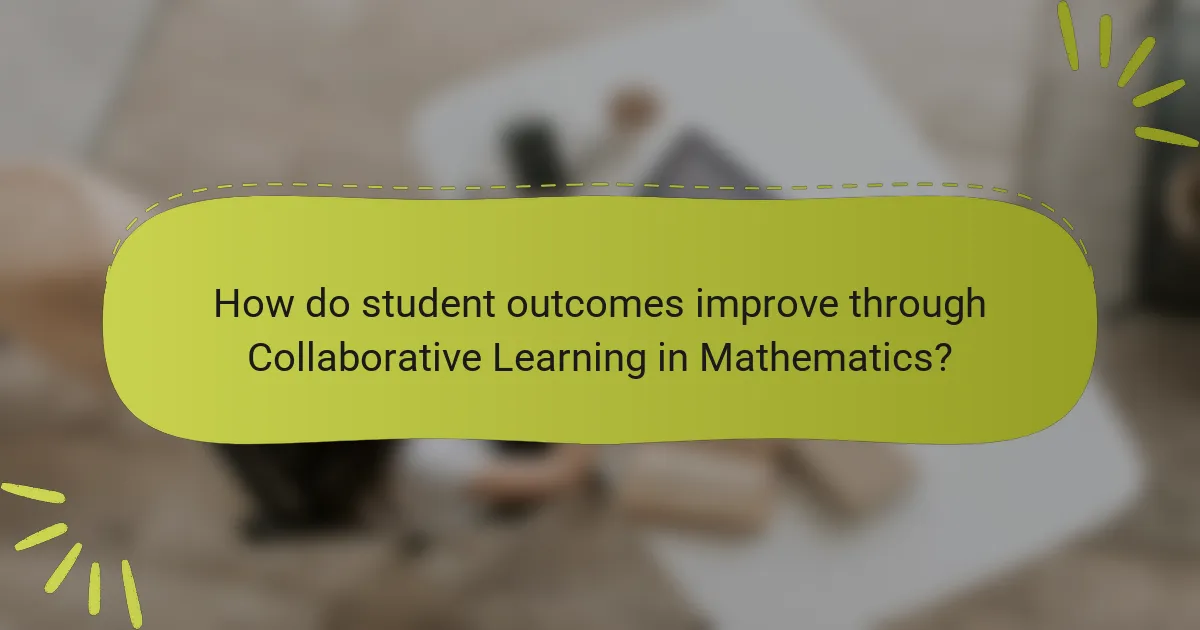
How do student outcomes improve through Collaborative Learning in Mathematics?
Student outcomes improve through Collaborative Learning in Mathematics by enhancing understanding and retention of concepts. This approach encourages active engagement among students. When students work together, they can share diverse perspectives. Collaborative learning fosters communication skills and critical thinking. Research shows that students involved in collaborative learning perform better on assessments. A study by Johnson & Johnson (2014) found that cooperative learning increases achievement by 20-25%. This method also promotes a positive attitude towards mathematics. Students develop a sense of responsibility for their peers’ learning. Overall, collaborative learning creates a supportive environment that leads to improved academic performance.
What evidence supports the effectiveness of Collaborative Learning in Mathematics?
Collaborative Learning in Mathematics has been shown to enhance student engagement and understanding. Studies indicate that students working in collaborative groups perform better on mathematics assessments. For instance, a meta-analysis by Johnson, Johnson, and Stanne (2000) revealed that cooperative learning methods lead to higher achievement in mathematics compared to traditional instruction. Furthermore, research by Hattie (2009) emphasizes that collaborative learning strategies can significantly improve student outcomes, with effect sizes indicating substantial benefits. These findings demonstrate that collaborative learning not only fosters deeper comprehension but also encourages critical thinking and problem-solving skills in mathematics.
How do test scores compare between traditional and collaborative learning methods?
Test scores generally show that collaborative learning methods outperform traditional methods. Research indicates that students engaged in collaborative learning often achieve higher scores on assessments. A meta-analysis conducted by Johnson, Johnson, and Stanne in 2000 found that collaborative learning can lead to academic achievement that is 0.5 standard deviations higher than traditional methods. Additionally, studies have shown that collaborative learning enhances critical thinking skills, which correlates with improved test performance. In mathematics specifically, a study by Laal and Ghodsi in 2012 highlighted that students in collaborative settings scored significantly higher than their peers in traditional classrooms. These findings suggest that collaborative learning methods are more effective in boosting test scores compared to traditional approaches.
What long-term benefits do students gain from Collaborative Learning in Mathematics?
Students gain several long-term benefits from Collaborative Learning in Mathematics. These benefits include improved critical thinking skills. Collaborative learning encourages students to analyze problems collectively. This interaction fosters deeper understanding of mathematical concepts. Additionally, students develop stronger communication skills. They learn to articulate their thoughts and listen to others. This teamwork enhances their ability to work in diverse groups. Furthermore, students often exhibit increased motivation and engagement. The social aspect of collaboration makes learning more enjoyable. Research shows that collaborative learning can lead to higher academic achievement over time. A study by Johnson & Johnson (1999) found that students in collaborative settings perform better than those who learn individually.
What challenges might arise in Collaborative Learning settings?
Challenges in Collaborative Learning settings include unequal participation among group members. Some students may dominate discussions while others remain passive. This can lead to imbalanced learning experiences. Conflict may arise due to differing opinions or working styles. Such disagreements can hinder group progress and create a negative atmosphere. Additionally, coordination issues may occur, complicating task management. Students may struggle to align their schedules or responsibilities. Lastly, assessment of individual contributions can be difficult. Teachers may find it challenging to evaluate each student’s performance accurately. These factors can undermine the effectiveness of collaborative learning.
How can educators address common obstacles in Collaborative Learning?
Educators can address common obstacles in Collaborative Learning by implementing structured group roles. Assigning specific responsibilities helps clarify expectations for each student. This approach promotes accountability and encourages active participation. Additionally, providing clear guidelines enhances communication among group members. Educators should also facilitate training on teamwork skills. Research indicates that students benefit from explicit instruction in collaboration techniques. Furthermore, monitoring group dynamics allows educators to identify and resolve conflicts early. Regular feedback sessions can improve group effectiveness. These strategies collectively enhance the collaborative learning experience in mathematics.
What strategies help maintain group cohesion during Collaborative Learning?
Effective strategies to maintain group cohesion during Collaborative Learning include establishing clear goals, fostering open communication, and encouraging mutual respect. Clear goals provide a shared purpose, guiding the group’s efforts. Open communication allows members to express ideas and concerns, strengthening connections. Encouraging mutual respect creates a positive environment, where all contributions are valued. Additionally, team-building activities can enhance relationships among members. Research indicates that cohesive groups perform better academically. A study by Johnson and Johnson (2014) found that collaborative learning enhances social skills and group dynamics. These strategies collectively promote a supportive atmosphere, essential for successful collaborative learning in mathematics.
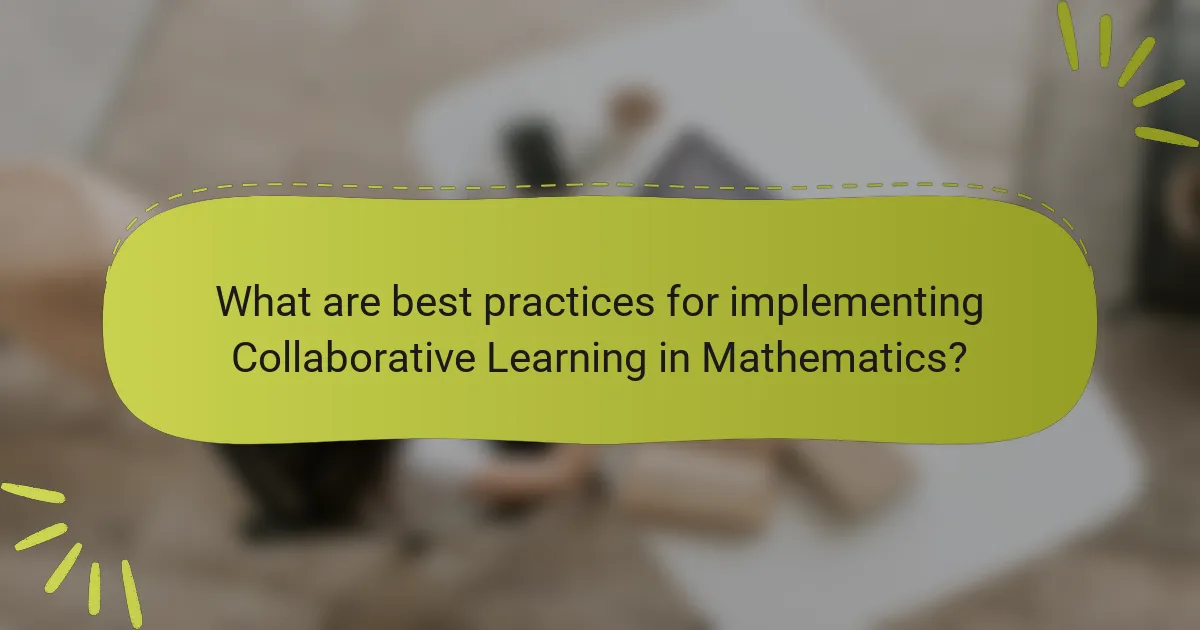
What are best practices for implementing Collaborative Learning in Mathematics?
Best practices for implementing Collaborative Learning in Mathematics include forming diverse groups, establishing clear goals, and providing structured activities. Diverse groups enhance perspectives and problem-solving approaches. Clear goals ensure students understand the objectives of collaboration. Structured activities guide interactions and keep students focused on tasks. Regular feedback is essential to assess group dynamics and individual contributions. Additionally, integrating technology can facilitate communication and resource sharing among students. Research shows that these practices improve engagement and learning outcomes in mathematics. Studies indicate that collaborative learning can lead to higher achievement levels and deeper understanding of mathematical concepts.
How can teachers effectively design Collaborative Learning experiences?
Teachers can effectively design Collaborative Learning experiences by incorporating structured group activities. These activities should have clear objectives and defined roles for each student. Teachers must ensure that tasks promote interdependence among group members. This encourages collaboration and communication.
Additionally, providing a framework for reflection is crucial. Students should assess their group dynamics and individual contributions. Research shows that structured reflection enhances learning outcomes. For example, a study by Johnson and Johnson (2014) highlights that cooperative learning significantly improves student achievement in mathematics.
Incorporating diverse learning styles into group tasks can also enhance engagement. This ensures that all students contribute according to their strengths. Finally, ongoing assessment and feedback are essential. Regular check-ins allow teachers to adjust strategies as needed.
What role does assessment play in Collaborative Learning environments?
Assessment plays a crucial role in Collaborative Learning environments by evaluating both individual and group performance. It helps identify students’ understanding and skills in mathematics. Effective assessment informs instruction and guides future learning activities. It also fosters accountability among group members. Assessments can be formative, providing ongoing feedback during the learning process. They can also be summative, measuring overall achievement at the end of a learning unit. Research indicates that regular assessments enhance student engagement and motivation. According to a study by Johnson and Johnson (2009), assessment in collaborative settings promotes deeper learning and improves academic outcomes.
How can feedback be integrated into Collaborative Learning processes?
Feedback can be integrated into Collaborative Learning processes through structured peer assessments. This method allows students to evaluate each other’s contributions. It encourages active engagement and reflection on the learning material. Additionally, instructors can provide timely and specific feedback during group activities. This supports students in understanding their strengths and areas for improvement. Research shows that feedback enhances learning outcomes by promoting deeper comprehension. According to Hattie and Timperley’s model, effective feedback can lead to significant gains in student performance. Therefore, integrating feedback in collaborative settings fosters a more effective learning environment.
What tips can enhance the success of Collaborative Learning in Mathematics?
Encouraging open communication enhances the success of collaborative learning in mathematics. Students should feel comfortable sharing ideas and asking questions. Establishing clear roles within groups promotes accountability. Assigning specific tasks to each member ensures engagement. Utilizing diverse problem-solving strategies fosters creativity. Integrating technology can facilitate collaboration and organization. Providing regular feedback helps students improve their understanding. Lastly, reflecting on group processes encourages continuous improvement.
How can educators foster an inclusive environment for all learners?
Educators can foster an inclusive environment for all learners by implementing diverse teaching strategies. These strategies include differentiated instruction, which tailors learning experiences to meet individual student needs. Collaborative learning activities can encourage peer interaction and support among students. Incorporating culturally relevant materials helps all students feel represented and valued. Regular feedback from students can guide educators in adjusting their approaches. Training in cultural competence equips educators to address diverse backgrounds effectively. Research shows that inclusive classrooms enhance student engagement and learning outcomes. A study by the National Center for Learning Disabilities highlights that inclusive practices improve academic performance for all students.
What resources are available to support Collaborative Learning in Mathematics?
Resources available to support Collaborative Learning in Mathematics include online platforms, educational software, and community forums. Online platforms like Google Classroom facilitate group work and communication among students. Educational software such as Kahoot! and Desmos promotes interactive learning experiences. Community forums provide spaces for students to discuss concepts and share resources. Research indicates that collaborative learning enhances problem-solving skills and understanding of mathematical concepts. Studies show that students engaged in collaborative learning perform better academically.
Collaborative Learning in Mathematics is an educational approach where students work together to solve problems, enhancing understanding through peer interaction. This article explores the techniques and principles that underpin collaborative learning, such as group problem-solving and peer teaching, while highlighting its benefits, including improved academic performance, critical thinking, and communication skills. Additionally, it addresses the impact of group dynamics, technology integration, and assessment strategies on student outcomes, providing evidence from research studies that support the effectiveness of collaborative learning in mathematics education. Overall, the article presents a comprehensive overview of how collaborative learning fosters a supportive and engaging environment for students.
